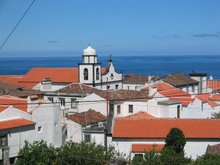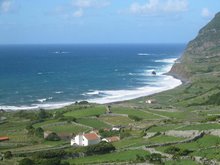I left you last time in 685AD and, as nothing much happens in the history of Scotland until 795AD (he says casually dismissing 110 years), I thought I'd take a quick digression into Christianity - not the mysteries of the Holy Trinity or anything but rather how, when and by whom Christianity was introduced to Scotland.
The short answer is nobody knows.
Christianity was introduced to Britain under the aegis of the Roman Empire some time during the first four centuries AD: it became the "official" religion of the Empire in 392AD but had been prevalent for a bit before then (give or take the odd throwing of a martyr to lions).
One candidate is Saint Ninian. The Venerable Bede - who sounds like a DJ but was actually history's first recorded Geordie and, pictured below, a monk at a monastery at Jarrow on Tyneside - wrote a book called "A History of the English Church and People" in the early 8th century which reported that Ninian had a church called Candida Casa (Latin for "white house" for reasons I forget now) which translated into Anglo Saxon (i.e. English) as Withern (sp?), the place we now know in Galloway in south west Scotland as Whithorn. As I recall, Bede claimed Ninian "converted the southern Picts" or some such extravagant statement. It's unlikely but who knows. When? Late 400s AD, I think

At which point we might as well fast forward another 150+ years to 563AD when Saint Columba arrived in Scotland. He was an Irish nobleman who had fallen out with someone over borrowing a psalter and as a result was banished to Scotland. I don't know what a psalter is but it must have something pretty special to warrant banishment to Scotland (although could have been worse - could have been Wales). Anyway, apparently Columba set sail and resolved not to stop until he reached somewhere from where he could no longer see Ireland. So he stopped on the island of Iona off the west coast of Scotland.



Did anyone notice, incidentally, how we've taken it for granted that Ireland was already Christian at this point (mid 6th cent. AD) when Scotland wasn't? That's got something to do with Saint Patrick - 5th cent., I think, but I'm not going to dwell because a) this is the history of Scotland without looking it up; and b) I don't know. What I do know is the Irish were Gaels and that a tribe of Gaels from Ireland called Scots had been settled in a part of south west Scotland called Argyll - which includes Iona - for a good few centuries prior to 563AD and had established a kingdom called Dalriada. So when Columba arrived on Iona, he was not really "abroad" - he would have been able to understand the locals. So it's a bit like being banished to Canada (Ugh! - I think I'd prefer Wales.)
Anyway, Columba founded a monastery on Iona and died there in 597AD. (Important thing to note about Iona is that all the numerous ecclesiastical buildings and ruins you can see there today which make it such a tourist draw are much later than Columba's time: his monastery would have consisted of wooden buildings of which no trace now remains.) Anyway, everything we know about Columba comes from a biography of him written by a later abbot of Iona, Saint Adomnan, who lived in the mid 7th century, about 50 years after Columba died.
Now, Adomnan made a lot of extravagant claims about Columba, about how many miracles he performed and all that guff, but nowhere does he claim that Columba actually converted anyone to Christianity. So are we to infer from that that Argyll and big lumps of neighbouring Scotland were maybe already Christian around the 550AD mark? It's entirely plausible.
This is the problem with the Dark Ages - nobody knows. Brilliant as the Celts and Anglo Saxons were at carving enigmatic symbols on standing stones and crosses, they were rubbish at writing down hard facts. Those who did write were usually clergymen more concerned to record miracles than useful facts. There were also the Annals of Gaelic (Irish and Scottish) culture which as I understand it was writing down dates of significant events to assist calculating the date of Easter each year. Don't ask me how that worked in practice but, as historical records go, Annals are incredibly frustrating and tend to include such delphic statements as "In this year, Brian O' Flaherty was killed in battle." But without telling us who Brian was or who killed him in battle or why.

So the thing about the Dark Ages is you have to try to piece the story together from clues in the written records of the time. So if Adomnan tells us that Columba performed a miracle at the court of King Bridei of the Picts, the only thing worth taking from that is that there was a King Bridei of the Picts sometime between 563 and 597AD. It's a start when there's nothing else to go on. And if Adomnan doesn't mention Columba converting anyone (which he surely would have done if he had) then what we are we to infer - Columba a rubbish saint or maybe he was too late and everyone was already a Christian?




11 comments:
"So the thing about the Dark Ages is you have to try to piece the story together from clues in the written records of the time."
Sounds like my travails in attempting to reconstruct the Flores side of my genealogy in the 19th century (sigh).
"What I do know is the Irish were Gaels and that a tribe of Gaels from Ireland called Scots had been settled in a part of south west Scotland called Argyll - which includes Iona - for a good few centuries prior to 563AD."
OK, so what inquiring minds REALLY want to know is, Were they wearing diamond-patterned socks?
The Scottish history lessons are great, though I have only skimmed over them (I like the hand-drawn maps) so that I can start at Part I and get the facts in the right order as I travel through the centuries. Psalter = book of psalms/prayers? Here is a fact from today's Metro: Sigurd the Mighty, Earl of Orkney late 9thC, beheaded a luckless individual, then tied the head to his horse's saddle. On the way home, the beheadee's tooth bit said Sigurd, who then expired of infection. Ha!
Mary, in the alternative (guess Sigurd's story is getting around!):
Bol druhým Vikingom, ktorý nastúpil po jeho bratovi Ragnaldovi Múdrom. Jeho smrťmá spätosťs inváziou Vikingov na severe územia dnešného Škótska, ktoré Sigurd viedol. Keď porazil vodcu protivníkov Maelbrigte-a. Maelbrightovi odťal hlavu a pripútal si ju k svojmu sedlu. Keď jazdil na koni, zuby z odťatej hlavy mu poškriabali nohu, dostal infekciu, na následky ktorej zomrel.
From "Najbizarnejšie úmrtia histórie!" in Aktuality of Brartislava:
http://www.aktuality.sk/clanok/140965/najbizarnejsie-umrtia-historie
Gah! Bratislava.
Oh Bratislava ? - that's cleared that up, then. Here is a link to the Orkney version of the invaziou Vikingov ...infekciu: www.orkneyjar.com/history/historicalfigures/sigmighty.htm
Thanks, Mary! I've forward the link to my husband, who teaches dental microbiology/immunology, so is always on the lookout for real-life examples (usually of the "ripped from the headlines" ilk) to add to his lectures in order to teach his students re the value of knowing about the hazards of infectious oral diseases -- especially off-beat ones. Of course, not as many folks go riding around the countryside on horseback nowadays with severed heads hanging from their saddles as used to a millennium or so ago ;-)
The complete URL is:
http://www.orkneyjar.com/history/
historicalfigures/sigmighty.htm
Mary, I've heard the tooth story although I couldn't have named the protagonists. I think it appears in Orkneyinga Saga along with many other barely credible stories like one about someone who rode so hard through a forest in Caithness that low branches knocked his head off. The nugget of fact historians draw from this is that there was a forest in Caithness back then which there ain't now (disregarding the bastard creations of the Woodland Grant Scheme (of unfond memory) of the last three decades).
Kathie - my Croato-Slovarian is rusty these days but is Bratislava twinned with Kirkwall or something?
Och, I just believe whatever I read - I like the mental pictures. If I'm in Caithness, I'll be slithering along the ground to avoid the branches
Carol & Neil, After I found the anecdote online in what appeared to be Slovakian, I ran it through Czech-to-English translating software, which provided a rough yet close enough rendering to ascertain that it was indeed most likely the same tale.
BTW, you should see how these programs mangle Portuguese-to-English! No accounting for idioms, colloquialisms, etc., just word-for-word decoding, with occasionally incomprehensible if not risible results. At the risk of sounding utterly self-promoting, I feel compelled to add that no Artificial Intelligence program will replace human translators -- at least not in my lifetime. Or at least I certainly hope they don't ;-)
http://translation.babylon.com
Endless hours of hilarity online.
Post a Comment